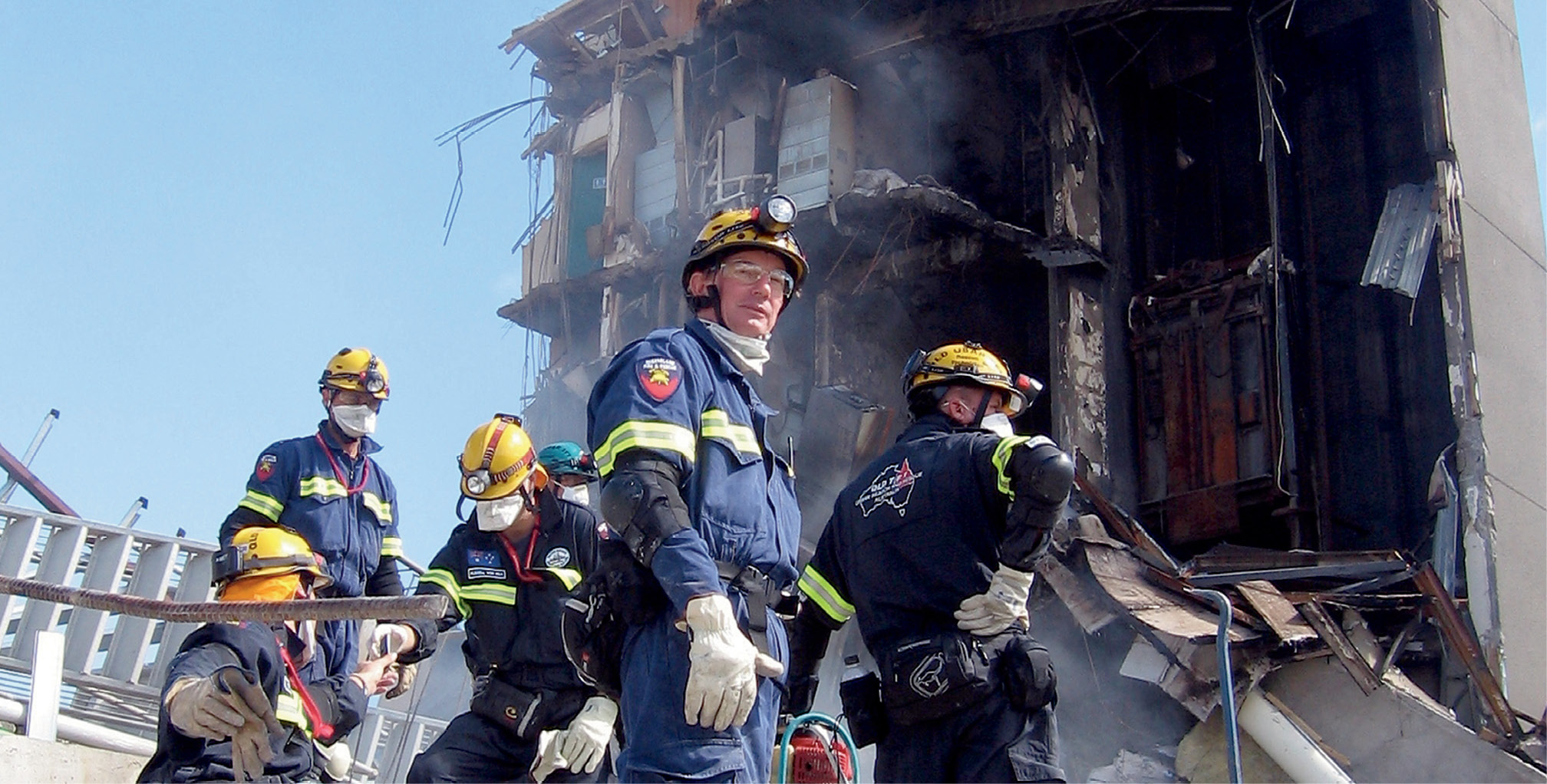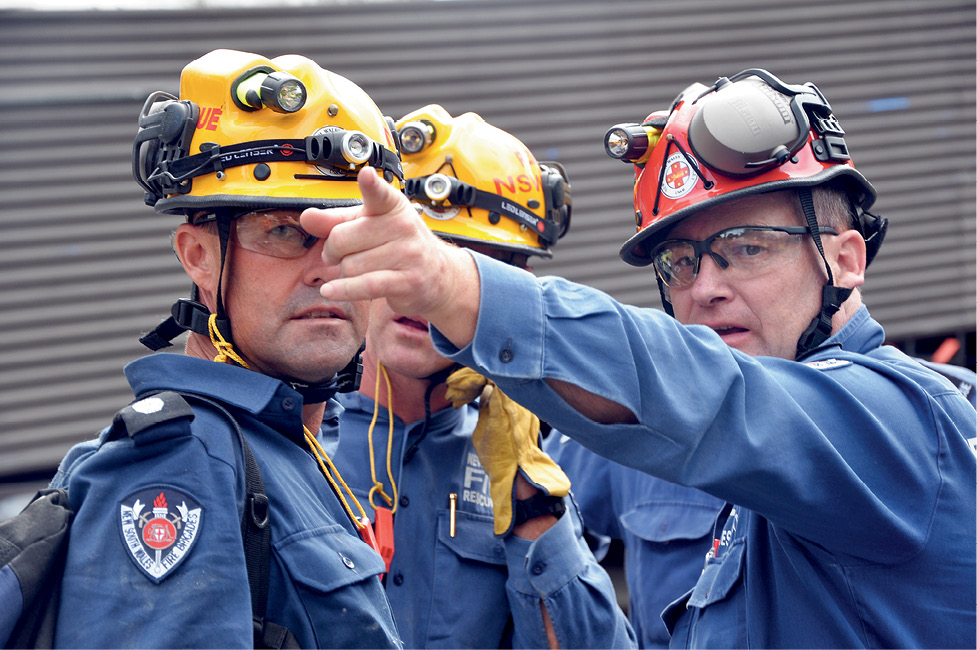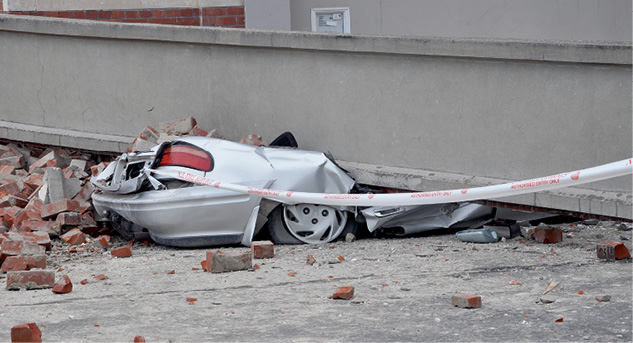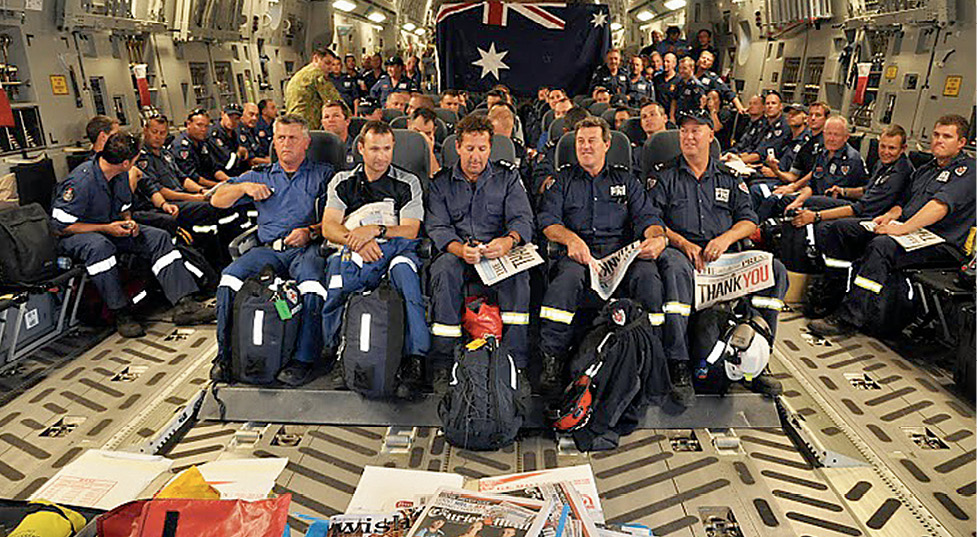Global help is on its way
Kate Lahey
Article
On the asphalt of a Christchurch street, in front of a large hotel, a message had been sprayed in orange paint: ‘Help is on its way’.
Bed sheets were hanging out of the hotel’s windows, like streamers, and fires were burning across the city.
Bruce Cameron and his team saw the words on the road as they took their first steps through Christchurch, around dawn on February 23.
As the first international Urban Search and Rescue (USAR) team to land, they’d arrived from Australia just 16 hours after the 6.3 magnitude earthquake struck.

Bruce Cameron and team on site in Christchurch.
“There were people still on top of buildings, there were fire appliances at work extinguishing fires. It hadn’t got to the stage where it was under control,” Mr Cameron says.
“It took me by surprise and I’ve been in it 30 years. It took everyone by surprise,” he says.
There were 36 members of the team, with 10 tonnes of gear. At the request of their New Zealand counterparts, Mr Cameron and half the group immediately set out on patrol.
“They (the New Zealanders) said, ‘go out and find where you think the hotspots are and where the people need to be deployed,’ and we came back and said, ‘basically, everywhere’.” Mr Cameron says.
They were then directed to the Pyne Gould Guinness building, which had collapsed. Mr Cameron says the New Zealand team leader handed over the site to him, saying: ‘It’s all yours, mate. There are about 20 people missing, 20 people in there, they’re all yours. We don’t know whether they’re dead or alive. We’re about to fall over, we’ve just got another two or three out this morning.’
It was here that Mr Cameron and his team found and freed Christchurch resident Ann Bodkin, after an Australian Channel Nine crew heard her through the rubble.
Ms Bodkin had been pinned under her desk for 26 hours by the time she was pulled to safety.
“She was almost out, we were just getting out on the end of a hydraulic fire ladder and a big aftershock came,” Mr Cameron says.
Rubble and steel fell down around the site as Ms Bodkin’s husband stood watching the rescuers. “I thought, this is all going to go belly-up now,” Mr Cameron says. “The lot’s going to cave in on top of her. Getting her out was extremely dangerous. You wouldn’t have done it if it was to recover a deceased person.
“We just took the risk I suppose, a balanced risk, to do what we did because she was a live victim and because she was in good spirits and good health we had to do what we had to do.”
Mr Cameron says that success was a career highlight. “She was a bit of a miracle I suppose to get out in the way she did, and she was the last person to be found alive.”
Just weeks earlier, Mr Cameron was pulling people, and one body, out of floodwaters in Queensland as part of a swiftwater rescue team. Six years earlier, he was wheeling patients in and out of a makeshift surgery in Banda Aceh. This was not the career he imagined when he first joined the NSW fire service in the early 1980s.
Now, trained to the highest international standards, he is one of hundreds of Australian emergency service workers who know how to respond to almost anything. It is these specially trained firefighters, police officers and paramedics, as well as doctors, engineers, and search dogs who are on call to form a USAR team when disaster strikes.
Queensland and NSW have both developed their USAR teams to meet the highest United Nations standards, and the two states alternate at being ‘on call’ internationally. The Australian Government has contributed funding to enhance the USAR capabilities.
NSW Fire and Rescue Chief Superintendent John Denny has watched the USAR taskforces evolve from the time of the Thredbo landslide in 1997, when he held the position of rescue manager. Thredbo identified gaps in Australia’s capability, he says, and events like the 2000 Sydney Olympics provided even greater impetus to improve Australia’s resources and join an international network.
Mr Denny also worked in both the Queensland floods and Christchurch but says the real heroes were the local communities in those areas who responded first to the disasters. “We just do a job that we’re well trained to do,” he says. Mixing with other international teams in Christchurch also highlighted some cultural differences, he said. “We integrated our team in to the teams from Japan and China,” he says.
When a request for help comes to the Australian Government from another country, Emergency Management Australia helps to coordinate the deployment of a USAR team.
The Australian teams have been used regularly in the past in various countries but have never been in such demand as they were for the first three months of this year, NSW Fire Commissioner Greg Mullins says.
“We’ve had other periods, after the tsunami 2004 we sent portions of our capability to Banda Aceh, the Maldives, Sri Lanka and Thailand, but just in logistic support roles setting up tents, food, water, sanitation and assisting with medical teams,” Mr Mullins says.
“There’ve been some deployments following earthquakes over the years to Turkey, Taiwan, Indonesia and a couple of times Queensland teams have also been sent to Samoa and Sumatra - but never an entire team.”
Mr Mullins says he had become accustomed to thinking of USAR as having a menu of capabilities, and that occasionally some items on that menu were called upon.
“All of a sudden in January this year, in the Queensland floods we were called to deploy a medium taskforce of about 36 up there as well as two swiftwater rescue teams,” Mr Mullins says.
“That was the first thing, and we thought wow, that’s pretty big. Then all of a sudden Christchurch and that was the first time we’d had an overseas deployment of a heavy rescue taskforce of 72 people, and 20 tonnes of equipment.”

The NSW team in action.
The equipment included tents, sleeping gear, portable showers, two full sets of gear for cutting through concrete and steel, cameras on long poles and seismic and acoustic devices for sensing human movement and sound such as moaning or scratching through the rubble.
They also packed 24-hour ration packs of dehydrated food. “There are cracker biscuits, squeeze tubes of jam and one bar of chocolate,” Cameron says. “There’s not much in there, just enough to sustain you for 24 hours, and that’s really all you live off for 10 days, you’re just about ready to eat the packet for a bit of variety. And we took our own water. We can’t be in any way an impost on the community we’re going in to help.”
A second NSW team and a full, or ‘heavy’, Queensland taskforce followed Mr Cameron’s’ team to Christchurch, both landing later that same day. When the time came to replace them, authorities looked to other states as well.
“We made sure that we had people from every state and territory so that the lessons would go throughout Australia,” Mr Mullins says.
As the second Australian taskforce was working in Christchurch, another devastating earthquake shook the region, this time in Japan. Rob McNeil, a NSW firefighter, happened to be rostered on. He also happens to know a lot about radiation risks.
Since 1994, Chief Superintendent McNeil, the Assistant Director of Community and Corporate Risk, has been training in and working with hazardous materials.
He has also developed good contacts within organisations such as the Australian Nuclear Scientific Technical Association (ANSTA). As he drove to Ingleburn to get his taskforce ready to leave, he called one of these contacts and asked if he had any spare radiation monitoring equipment, and specifically any dosimeters his team could wear. Dosimeters are badges that measure radiation exposure and can alert the wearer when levels are high. By the time Mr McNeil reached Ingleburn, the dosimeters were there.
On Sunday, March 13, Mr McNeil and his heavy taskforce of 76 landed at the United States Airforce base in Yokota, about 300km from where they needed to start searching for people to rescue.
“The roads were broken up, the power supplies were gone, the water supplies were interrupted,” he says. Finding a truck was hard and finding a driver who wasn’t too scared to take them where they needed to go was another challenge.
He describes that journey to Minamisanriku as ‘an operation in itself’. It took two days and a lot of help from the Department of Foreign Affairs and Trade, Emergency Management Australia and the Australian and US military, he said.
“When we started to drive up through the areas, it became evident that these major highways had major cracks in them. Then we were getting messages back saying, ‘you’re going to have to stop 5km short because there are no roads into this place, there’s three or four metres of silt on top of them, and you’re going to have to traverse this’. It basically looked like a rubbish tip,” he says.
“We thought, well, we’ve got 20 tonne worth of equipment and if we’re going to go and do search and rescue we’re going to have to carry this equipment with us,” Mr McNeil says. “The logistics of this deployment started to really challenge my thinking.”

Car demolished by girder.
Despite the risk of radiation, aftershocks and below-freezing weather, the members of the taskforce decided their biggest threat was another tsunami, so they set up camp away from the coast. They slept in tents, while at night the temperature dropped to minus 17 degrees.
Mr Mullins says this Japanese experience was like nothing an Australian USAR team had witnessed before.
“It was just total devastation,” he says. “Normally when the USAR team moves into an area, they contact the local emergency management authority. Well, they weren’t there. Our people became the authority because all that were left were some remnants of families trying to survive.”
Mr McNeil describes a similar scene. And the rescue work itself provided no comfort.
“As opposed to a building collapse where there may be voids and you may be able to find people, this was more like a tea strainer. The water rushes out, everything’s just smashed into one area and those areas were buildings,” he says.
“Normally, even in a pancaked building, where there’s a void of more than about 24 inches, there can be life. But these voids in this area all would have been filled with water. So the chance of finding life was drastically reduced, but we were still there on a search and rescue mission and we always have that hope.”
When things felt tough, he says, the team thought of Australian soldiers in Afghanistan. “We didn’t have anyone shooting at us, and we knew it was only going to be for 10 days,” he says.
All the while, Mr McNeil was receiving advice from home, from the Australian Radiation Protection and Nuclear Safety Agency (ARPANSA) and predictions for the radiation plume. The taskforce also had a back-up plan a fleet of US Blackhawks. The military helicopters were nearby and ready to evacuate the Australians at a moment’s notice.
The plume never came, but there was one medical evacuation. A member of the taskforce had tried to help one of the two Australian search dogs, who was stuck on a wire fence. The dog reacted by biting his face and tearing his top lip apart.
A US frog helicopter flew the man to a US medical base where a plastic surgeon repaired the damage.
“We brought both dogs home. Even the naughty one,” Mr McNeil says.
“They were fantastic but the handlers were quite concerned that those dogs were in Christchurch also. They’re live victim locators and if they keep finding deceased people, they start to lose that capability because they’re not getting rewarded.”
Mr Mullins held similar fears for his people.
“They had constant aftershocks and the fear of another tsunami, so wherever they worked they had to have escape routes,” Mr Mullins says.
“There were piles of debris and everything you could think of, trees mixed in with bits of timber from homes, mixed in with cars, and the dogs would indicate there might be someone in there, so they’d have to dig through. They’d come to big chunks of soil with tree roots and have to dig through it and it was all frozen. It was quite horrific.
“They did find remains of humans, but as we found in Banda Aceh, there wasn’t a lot that was recognisable, it was just that the dogs had indicated them.”
Ultimately, they found no one alive.
“There was a psychological impact,” Mr Mullins says. “The whole focus of USAR teams is to find living victims and get them out to medical care, so morale could have bottomed out pretty quickly.” Keeping morale up became one of the biggest challenges, he says.
This experience, and a similar one in Christchurch where rescue work quickly turned into body recovery has led to one of three changes the Australian USAR teams will now use in future disasters.
For NSW teams, an extra person will now be embedded in each taskforce to act as a debriefer.
“It’s having someone there on the spot, rather than wait until they get home to start that psychological recovery. It’s psychological first aid,” Mr Mullins says.

The rescue team coming back home to Australia.
“So, just having a chat, then saying, this person needs to pull back to a logistics role for a while so we can rotate people into different roles.
“If somebody has a particularly nasty rescue job, lots of dismembered bodies, we can say ‘ok, tomorrow you’re coming off the rubble and we’ll have you back in the base’.”
Such people were used in Christchurch and Japan though the team members sometimes took a bit of convincing.
“Their comments were: ‘yeah I don’t feel too good, but look at those poor people, they’ve lost their whole village, they’ve got no grandparents, parents, cousins, sisters they’re all gone. So who am I to whinge?’” Mr Mullins says.
Queensland Fire and Rescue Chief Superintendant John Cawcutt’s taskforce in Christchurch found no live victims, but pulled 45 bodies from the CTV building in an intensely short period of time. Once this became apparent, his state flew a team of four people over to begin the psychological recovery process before the taskforce flew back to home soil, he says.
Queensland has 275 people trained to the highest USAR standards and NSW has 220. With demand as high as it was this year, deciding who should be deployed, and how often, was tough.
Many Queensland rescuers were exhausted by the time help from NSW, and every other state and territory, arrived.
“The guys were hammered, from mid December,” Mr Cawcutt says. “Normally if you have one disaster, that’s enough. But we had north Queensland flooding, then central Queensland flooding, south-west Queensland flooding then we had the Brisbane floods and the Lockyer Valley disaster, and Toowoomba. Then we had cyclone Yasi.”
“The USAR and our technical rescue staff were stretched to their absolute limit. A lot of the guys did two or three deployments.”
Mr Mullins says the NSW service tried not to double up. In the four deployments one to Queensland, two to Christchurch and one to Japan, about 150 NSW people were deployed, in total.
“The hardest thing we find is telling people they can’t go,” Mr Mullins said. “The type of people we’re talking about, ambulance officers, fire officers, police officers, they’re just natural helpers.
“So, whenever there’s a disaster anywhere in the world, expectation management becomes one of the biggest challenges in our organisation because they all want to go and they all think they should be there helping.
“All the people who’d just come back from Christchurch just wanted to up sticks and go to Japan. It’s very humbling when you work with people like that. They’re wonderful, but you have to be a bit tough and say ‘no, we have to spread this out and you mightn’t see it now, but it could damage you for life’.
“It’s like the 1994 bushfires, or the Thredbo landslide–the people who were there have all this corporate knowledge and the more of them we have, the better the organisation is,” Mr Mullins said.
Many states are simply not big enough to support the “triple depth” the UN requires for them to have their own full USAR teams, Mr Mullins says.
“We have to be able to put three taskforces in the field so if one goes we still have equipment and personnel for a second and then we have a domestic capability left over if we send two abroad,” Mr Mullins says.

The Queensland team in action.
“You have to be a very big organisation to do that. It’s a high-consequence but low-frequency event that we’re talking about, so there’s quite an investment and sometimes you don’t see the payoff for years.”
In Japan, Rob McNeil’s investment in radiation training paid off. He was very confident entering the areas he did, and says that led to confidence in his team.
“On our trip back, we did a risk assessment and we decided that a tsunami was more dangerous than driving through the Fukushima exclusion zone, so we drove. We all had our dosimeters and detectors on. We had the windows up and the air-conditioning on recycle and we wore protective dust masks and we all numbered and named our masks and handed them to ANSTA when we got home.
“Not one of them came up with any sign of radiation. The dosimeters determined the most exposed we got was background radiation.”
The second change being adopted by USAR teams is to ensure daily contact with the families of taskforce members–this proved crucial for those with loved-ones in Japan.
“We set up an SMS tree. Morning and night, we’d send messages to all the taskforce families, just giving them an update, and we’d ring every two days and say ‘here’s what’s going on’,” Mr Mullins says.
“They were hearing on the TV and radio that Australian rescuers were at risk from radiation contamination, and you could understand why the media said that, because the information was sketchy. But we were able to reassure them that wasn’t the case, and say ‘if it is the case, we’ve got an evacuation plan, the US Airforce has a fleet of Blackhawks, they’ll be out of there within an hour if the wind changes.
“The feedback we had from families was amazing. They were so grateful, because they were so worried.”
The third change is that a media officer will now be embedded in taskforces to relieve the taskforce leaders of handling inquiries.
When USAR teams are not freeing people from rubble, they find other ways to help. Rob McNeil’s team donated their full cache of medical equipment and supplies, tents and remaining food and water to the Japanese when they left. In Christchurch and Japan, the job of the Australian taskforces shifted from rescue work to community support.
Mr Cawcutt suspects USAR teams will be used a lot more in the future, because their skill sets are so broad and they’re extremely efficient and agile.
“We always look at ways of improving things but we’ve got to be careful too because the beauty of a USAR team is its ability to be mobile and quick. If you start to think ‘oh we could have had this bit of gear, or this or that,’ then your footprint starts getting bigger and you can start to lose that ability to be light,” he says.
Mr Mullins says the USAR work in New Zealand soon became community outreach. “They’d just go out, drive down a street, knock on a door, say ‘have you got any problems?’ They’d say ‘yes, we can’t get our garage door open, it’s wedged shut. So they’d fix it, or they’d do a bit of plumbing to fix the toilet, or they’d prop up a roof that was sagging,” Mr Mullins says.
“I had someone come up to me at the airport as I left Christchurch. I went over for a couple of days with Lee Johnson (the Queensland Fire Commissioner). This elderly lady came up and said, ‘have you been helping us?’ I said ‘no, no, I just came over to see our teams’ and she said ‘oh, well we’re just so grateful for your assistance’ and grabbed me and gave me a kiss’.” Mr Mullins said. “I had rather wet eyes. Our people told these similar stories and you’d see these big tough men tearing up because it was just so rewarding.”


